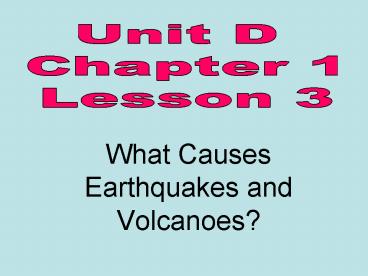What Causes Earthquakes and Volcanoes - PowerPoint PPT Presentation
1 / 15
Title:
What Causes Earthquakes and Volcanoes
Description:
They are the energy that travels through the earth and is recorded on seismographs. ... Seismograph. An instrument that detects earthquake waves. Seismogram ... – PowerPoint PPT presentation
Number of Views:2533
Avg rating:3.0/5.0
Title: What Causes Earthquakes and Volcanoes
1
Unit D Chapter 1 Lesson 3
- What Causes Earthquakes and Volcanoes?
2
Plate Movements Cause Earthquakes
- Earthquake
- Release of energy as vibrations that results from
a move in the tectonic plates or volcanic
activity. - Focus
- The point in Earths crust where the first major
movement along the fault occurs. - Epicenter
- The point on the Earths surface directly above
the focus of an earthquake.
3
(No Transcript)
4
Earthquake waves
- Seismic waves
- The waves of energy caused by the sudden breaking
of rock within the earth or an explosion. They
are the energy that travels through the earth and
is recorded on seismographs. - P wave
- Primary Waves or Push-pull waves that cause
back-and forth vibrations in the same direction
as the waves move.
5
(No Transcript)
6
Earthquake waves continued
- S wave
- Secondary Wave is the second wave you feel in
an earthquake. An S wave is slower than a P wave
and can only move through solid rock. This wave
moves rock up and down, or side-to-side.
7
Earthquake waves continued
- Surface Waves
- Waves that travel only at eh surface and move
less quickly than P and S waves. - Love Waves
- The first kind of surface wave is called a Love
wave, named after A.E.H. Love, a British
mathematician who worked out the mathematical
model for this kind of wave in 1911. It's the
fastest surface wave and moves the ground from
side-to-side.
8
Earthquake waves continued
- Rayleigh Waves
- The other kind of surface wave is the Rayleigh
wave, named for John William Strutt, Lord
Rayleigh, who mathematically predicted the
existence of this kind of wave in 1885. A
Rayleigh wave rolls along the ground just like a
wave rolls across a lake or an ocean. Because it
rolls, it moves the ground up and down, and
side-to-side in the same direction that the wave
is moving. Most of the shaking felt from an
earthquake is due to the Rayleigh wave, which can
be much larger than the other waves.
9
(No Transcript)
10
Earthquake waves continued
- Seismograph
- An instrument that detects earthquake waves.
- Seismogram
- The paper that has the recorded waves from an
earthquake on it.
11
(No Transcript)
12
Earthquake Safety
- Richter scale
- This is a scale that measures the amount of
energy released during and earthquake. - Mercalli scale
- Measures the amount of damage that an earthquake
causes.
13
(No Transcript)
14
(No Transcript)
15
(No Transcript)































